
Robotic Process Automation (RPA) is a technology that uses software robots or “bots” to automate repetitive, rule-based tasks typically performed by humans. These tasks often involve interacting with digital systems and software applications in a way that mimics human actions. RPA is designed to automate tasks that are highly structured and predictable, helping businesses increase efficiency, reduce errors, and free up human workers for more complex tasks.
Key Features of RPA
- Automation of Repetitive Tasks: RPA is used for automating tasks that involve data entry, form filling, processing transactions, extracting and transferring data between systems, and more.
- Non-Invasive Technology: RPA bots work by interacting with existing applications and systems, mimicking the actions of a human user without needing to modify the underlying infrastructure. This makes it a non-intrusive solution that can be implemented with minimal disruption.
- Scalability: RPA systems can handle a high volume of transactions and can be scaled up or down easily to meet business needs.
How RPA Works
RPA uses software robots that follow predefined workflows or business rules to execute tasks. These bots can perform actions like:
- Navigating software applications
- Copying and pasting data
- Extracting information from documents
- Interacting with databases
- Filling out forms
- Generating reports
RPA tools typically provide a visual interface that allows users to create automation workflows without needing to write complex code. These workflows consist of a series of steps that the bot will execute in the same sequence as a human worker would.
Types of RPA Bots
- Attended Bots: These bots require human intervention or are triggered by a user to perform tasks. They are typically used for tasks that require human oversight or collaboration.
- Example: A bot that assists a customer service agent by retrieving customer data when requested.
- Unattended Bots: These bots work autonomously, without human intervention. They are used for tasks that can run in the background, such as data processing or handling repetitive business workflows.
- Example: A bot that processes and uploads invoices to a system without human involvement.
- Hybrid Bots: A combination of both attended and unattended bots, designed to function in environments where both human intervention and automated processes are necessary.
Benefits of RPA
- Increased Efficiency: RPA bots can work faster than humans, processing tasks 24/7 without needing breaks, resulting in significant time savings.
- Reduced Errors: Since bots follow defined rules without deviation, the risk of human error is minimized.
- Cost Savings: By automating repetitive tasks, businesses can save on labor costs and reduce operational expenses.
- Enhanced Productivity: Employees can focus on higher-value tasks that require creativity, problem-solving, and decision-making, while RPA handles routine tasks.
- Improved Compliance: RPA can ensure that tasks are performed consistently and in accordance with regulatory requirements, reducing the risk of non-compliance.
Common Use Cases for RPA
- Data Entry and Data Extraction: RPA bots can extract data from emails, documents, or websites and input it into a database or system without human intervention.
- Invoice Processing: RPA can automate the collection, validation, and entry of invoice data into an accounting system, speeding up the accounts payable process.
- Customer Support: RPA bots can assist customer support teams by quickly retrieving customer information or processing requests for common services (e.g., password resets, account updates).
- Employee Onboarding: RPA can automate repetitive HR tasks, such as processing new hire paperwork, creating accounts, and assigning training.
- IT Management: Tasks like software updates, system monitoring, and log management can be automated with RPA to reduce manual IT workload.
- Healthcare: Automating patient data entry, insurance claim processing, and medical record management are common RPA applications in the healthcare industry.
Challenges of RPA
- Complexity of Setup: Although RPA is user-friendly in many cases, designing and implementing automation for complex or unstructured tasks can be challenging and may require skilled developers.
- Scalability and Maintenance: While RPA can scale efficiently, maintaining and updating automated processes as systems or processes change may require ongoing attention.
- Change Management: Organizations need to manage the transition to RPA carefully, ensuring that employees are adequately trained and understand how RPA will impact their roles.
- Not Suitable for All Tasks: RPA is best suited for rule-based tasks with well-defined workflows. It struggles with tasks that require judgment, creativity, or adaptability.
RPA Tools and Platforms
Some popular RPA tools and platforms include:
- UiPath
- Automation Anywhere
- Blue Prism
- WorkFusion
- Pega RPA
- Kofax
Conclusion
Robotic Process Automation (RPA) has become an essential tool for businesses looking to improve operational efficiency, reduce costs, and minimize errors by automating routine, repetitive tasks. While it is an effective solution for certain types of processes, successful implementation requires careful planning, proper training, and ongoing maintenance to ensure that automation delivers the desired benefits.




